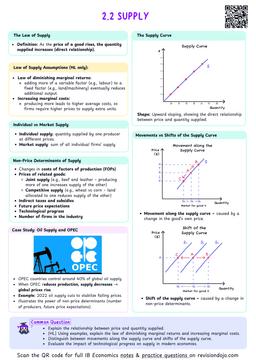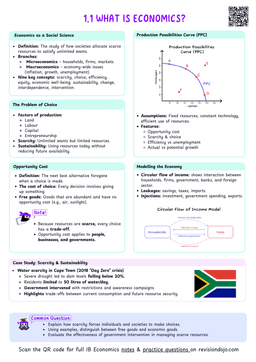Balance of Payments
A statement or record of a country's economic transactions with the all other countries over a specific time period (often a year).
The balance of payments has three components:
- Current account
- Capital account
- Financial account
Calculation: Elements of Balance of Payments
This table below will be utilised throughout the explanation of all components.
| Line | Components | Figures (Millions of dollars) |
|---|---|---|
| 1 | Current Account | |
| 2 | Exports of Goods | +25 |
| 3 | Imports of Goods | -50 |
| 4 | Balance of Trade in Goods (Line 2 - 3) | -25 |
| 5 | Exports of Services | +15 |
| 6 | Imports of Services | -5 |
| 7 | Balance of Trade in Services (Line 5 - 6) | +10 |
| 8 | Balance of Trade in Goods & Services (Line 4 + 7) | -15 |
| 9 | Income (inflows - outflows) | -4 |
| 10 | Current Transfers (inflows - outflows) | +1 |
| 11 | Balance on Current Account (Line 8 + 9 + 10) | -18 |
| 12 | Capital Account | |
| 13 | Capital Transfers (inflows - outflows) | +1.1 |
| 14 | Transactions non-financial assets (inflows - outflows) | +0.9 |
| 15 | Balance on Capital Account (Line 13 + 14) | +2 |
| 16 | Financial Account | |
| 17 | Foreign Direct Investment (inflows - outflows) (FDI; inflows - outflows) | +18 |
| 18 | Portfolio Investment (inflows - outflows) | -3 |
| 19 | Reserve Assets (official reserves) | +2 |
| 20 | Official Borrowing | -1 |
| 21 | Balance of Financial Account (Line 17 + 18 + 19 + 20) | +16 |
| 22 | Balance (Line 11 + 15 + 21) | 0 |
Current Account
Current Account
The current account is the sum of the balance of trade in goods and services, income and current transfers.
Balance of trade in goods
- Exports are the goods produced domestically in Country A and sold to foreign countries.
- The payment for these exports are received in the exporting country's currency.
- Hence, exports are considered to be credit as it is the inflow of money.
- Meanwhile, imports are the goods produced in foreign countries which are purchased by Country A.
- The payment for these imports are made in the country's currency Country A imports from (increasing supply of Country A's currency).
- Hence, imports are considered to be debit as it is the outflow of money.
- Thereby, the balance of trade in goods can be calculated by:
- $\text{Balance of Trade in Goods} = \text{Export of Goods} - \text{Import of Goods}$
Observing the table:
Country A's balance of trade in goods is -25 million dollars.
This is because:
$\text{Balance of Trade in goods} = +25 - 50 = -25 \text{ million dollars}$
Balance of trade in services
The same applies for services.
- Exports are the services created domestically in Country A and sold to foreigners.
- Services include tourism for foreign individuals, consulting, transportation, insurance, etc.
- When foreigners buy the following services, it is considered as the export of services.
- Hence, exports are considered to be credit as it is the inflow of money.
- Meanwhile, imports are the services created in foreign countries which are purchased by Country A citizens.
- When Country A citizens purchase tourism packages or insurance from foreign firms, it is considered as the import of services.
- Hence, imports are considered to be debit as it is the outflow of money.
- Thereby, the balance of trade in services can be calculated by:
- $\text{Balance of Trade in Services} = \text{Export of Services} - \text{Imports of Services}$
Observing the table:
Country A's balance of trade in services is +10 million dollars.
This is because:
$\text{Balance of Trade in services} = +15 - 5 = +10 \text{ million dollars}$
Balance of trade in goods & services
Often referred to as "Balance of Trade", it can be calculated by:
$\text{Balance of Trade} = \text{Balance of Trade in Goods} + \text{Balance of Trade in Services}$
ExampleObserving the table:
Country A's balance of trade in goods & services is -15 million dollars.
This is because:
$\text{Balance of Trade} = -25 + 10 = -15 \text{ million dollars}$
Income
Income is considered to be all the inflows and outflows of factor incomes: wages, interest, rent, and profits.
- Credits are inflows from foreign investments.
- This could also refer to Country A's citizens who might earn income from abroad such as having bank accounts which earn interest.
- Debits are outflows to foreign investors.
- This could refer to Country A citizens who might need to pay rent for housing abroad.
- Therefore, income is:
- $\text{Income} = \text{Inflow of Income} - \text{Outflow of Income}$
Observing the table, the inflow - outflow calculations had been provided.
Therefore, Country A's income is -4 million dollars.
Current transfers
Current transfers are inflows and outflows of funds for which no goods or services are exchanged.
- Credits are inflows from foreign aid, transfers from abroad such as remittances (money sent to close family in Country A from abroad) or gifts, and pensions.
- Debits are outflows for aid or remittances sent abroad.
- $\text{Current Transfers}$ $=$ $\text{Inflow into Country A}$ $-$ $\text{Outflow out of Country A}$
Observing the table, the inflow - outflow calculations had been provided.
Therefore, Country A's current transfers is +1 million dollars.
Balance on Current Account
- Summing up the components mentioned above provides us the current account balance.
- If there is a larger quantity of credits than debits, then Country A would have current account surplus.
- If there is a larger quantity of debits than credits, then Country A would have current account deficit.
Observing the table, the balance on current account is calculated from summing up all the three sub-components.
Therefore, Country A's balance on current account is -18 million dollars as:
$\text{Balance on Current Account} = -15 -4 + 1= -18 \text{ million dollars}$
Capital Account
Capital Account
The capital account is the sum of the balance of capital transfers and transactions in non-produced, non financial assets.
The current account and financial accounts are relatively larger than the capital account when comparing.
Capital Transfers
Capital transfers is the (inflows - outflows of) funds exchanged when an asset changes ownership from one party to another.
- Examples of capital transfers include: debt forgiveness, investment grants (provided by governments), sale of fixed assets, etc.


